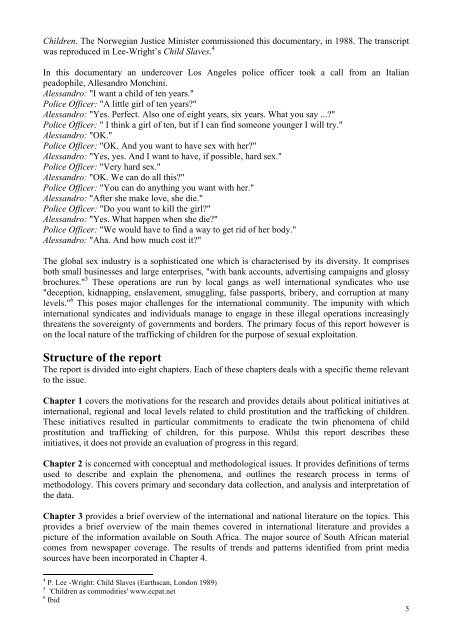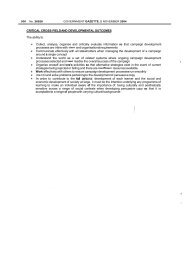The trafficking of children for purposes of sexual exploitation
The trafficking of children for purposes of sexual exploitation
The trafficking of children for purposes of sexual exploitation
You also want an ePaper? Increase the reach of your titles
YUMPU automatically turns print PDFs into web optimized ePapers that Google loves.
Children. <strong>The</strong> Norwegian Justice Minister commissioned this documentary, in 1988. <strong>The</strong> transcript<br />
was reproduced in Lee-Wright’s Child Slaves. 4<br />
In this documentary an undercover Los Angeles police <strong>of</strong>ficer took a call from an Italian<br />
peadophile, Allesandro Monchini.<br />
Alessandro: "I want a child <strong>of</strong> ten years."<br />
Police Officer: "A little girl <strong>of</strong> ten years?"<br />
Alessandro: "Yes. Perfect. Also one <strong>of</strong> eight years, six years. What you say ...?"<br />
Police Officer: " I think a girl <strong>of</strong> ten, but if I can find someone younger I will try."<br />
Alessandro: "OK."<br />
Police Officer: "OK. And you want to have sex with her?"<br />
Alessandro: "Yes, yes. And I want to have, if possible, hard sex."<br />
Police Officer: "Very hard sex."<br />
Alessandro: "OK. We can do all this?"<br />
Police Officer: "You can do anything you want with her."<br />
Alessandro: "After she make love, she die."<br />
Police Officer: "Do you want to kill the girl?"<br />
Alessandro: "Yes. What happen when she die?"<br />
Police Officer: "We would have to find a way to get rid <strong>of</strong> her body."<br />
Alessandro: "Aha. And how much cost it?"<br />
<strong>The</strong> global sex industry is a sophisticated one which is characterised by its diversity. It comprises<br />
both small businesses and large enterprises, "with bank accounts, advertising campaigns and glossy<br />
brochures." 5 <strong>The</strong>se operations are run by local gangs as well international syndicates who use<br />
"deception, kidnapping, enslavement, smuggling, false passports, bribery, and corruption at many<br />
levels." 6 This poses major challenges <strong>for</strong> the international community. <strong>The</strong> impunity with which<br />
international syndicates and individuals manage to engage in these illegal operations increasingly<br />
threatens the sovereignty <strong>of</strong> governments and borders. <strong>The</strong> primary focus <strong>of</strong> this report however is<br />
on the local nature <strong>of</strong> the <strong>trafficking</strong> <strong>of</strong> <strong>children</strong> <strong>for</strong> the purpose <strong>of</strong> <strong>sexual</strong> <strong>exploitation</strong>.<br />
Structure <strong>of</strong> the report<br />
<strong>The</strong> report is divided into eight chapters. Each <strong>of</strong> these chapters deals with a specific theme relevant<br />
to the issue.<br />
Chapter 1 covers the motivations <strong>for</strong> the research and provides details about political initiatives at<br />
international, regional and local levels related to child prostitution and the <strong>trafficking</strong> <strong>of</strong> <strong>children</strong>.<br />
<strong>The</strong>se initiatives resulted in particular commitments to eradicate the twin phenomena <strong>of</strong> child<br />
prostitution and <strong>trafficking</strong> <strong>of</strong> <strong>children</strong>, <strong>for</strong> this purpose. Whilst this report describes these<br />
initiatives, it does not provide an evaluation <strong>of</strong> progress in this regard.<br />
Chapter 2 is concerned with conceptual and methodological issues. It provides definitions <strong>of</strong> terms<br />
used to describe and explain the phenomena, and outlines the research process in terms <strong>of</strong><br />
methodology. This covers primary and secondary data collection, and analysis and interpretation <strong>of</strong><br />
the data.<br />
Chapter 3 provides a brief overview <strong>of</strong> the international and national literature on the topics. This<br />
provides a brief overview <strong>of</strong> the main themes covered in international literature and provides a<br />
picture <strong>of</strong> the in<strong>for</strong>mation available on South Africa. <strong>The</strong> major source <strong>of</strong> South African material<br />
comes from newspaper coverage. <strong>The</strong> results <strong>of</strong> trends and patterns identified from print media<br />
sources have been incorporated in Chapter 4.<br />
4 P. Lee -Wright: Child Slaves (Earthscan, London 1989)<br />
5 'Children as commodities' www.ecpat.net<br />
6 Ibid<br />
5
















